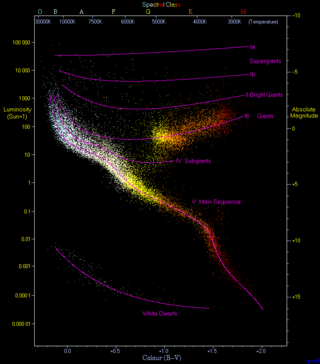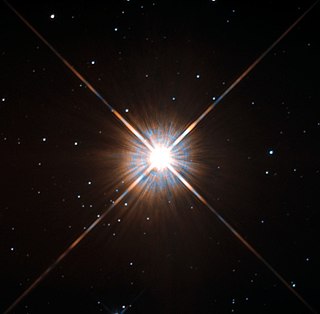Related Research Articles

The giant planets make up a diverse type of planet much larger than Earth. They are usually primarily composed of low-boiling point materials (volatiles), rather than rock or other solid matter, but massive solid planets can also exist. There are four known giant planets in the Solar System: Jupiter, Saturn, Uranus and Neptune. Many extrasolar giant planets have been identified as orbiting other stars.

In astronomy, the main sequence is a continuous and distinctive band of stars that appears on plots of stellar color versus brightness. These color-magnitude plots are known as Hertzsprung–Russell diagrams after their co-developers, Ejnar Hertzsprung and Henry Norris Russell. Stars on this band are known as main-sequence stars or dwarf stars. These are the most numerous true stars in the universe and include the Sun.

A star is an astronomical object comprising a luminous spheroid of plasma held together by self-gravity. The nearest star to Earth is the Sun. Many other stars are visible to the naked eye at night; their immense distances from Earth make them appear as fixed points of light. The most prominent stars have been categorised into constellations and asterisms, and many of the brightest stars have proper names. Astronomers have assembled star catalogues that identify the known stars and provide standardized stellar designations. The observable universe contains an estimated 1022 to 1024 stars. Only about 4,000 of these stars are visible to the naked eye—all within the Milky Way galaxy.

Stellar evolution is the process by which a star changes over the course of time. Depending on the mass of the star, its lifetime can range from a few million years for the most massive to trillions of years for the least massive, which is considerably longer than the current age of the universe. The table shows the lifetimes of stars as a function of their masses. All stars are formed from collapsing clouds of gas and dust, often called nebulae or molecular clouds. Over the course of millions of years, these protostars settle down into a state of equilibrium, becoming what is known as a main-sequence star.

A red dwarf is the smallest and coolest kind of star on the main sequence. Red dwarfs are by far the most common type of star in the Milky Way, at least in the neighborhood of the Sun. However, as a result of their low luminosity, individual red dwarfs cannot be easily observed. From Earth, not one star that fits the stricter definitions of a red dwarf is visible to the naked eye. Proxima Centauri, the nearest star to the Sun, is a red dwarf, as are fifty of the sixty nearest stars. According to some estimates, red dwarfs make up three-quarters of the stars in the Milky Way.

A dwarf star is a star of relatively small size and low luminosity. Most main sequence stars are dwarf stars. The meaning of the word "dwarf" was later extended to some star-sized objects that are not stars, and compact stellar remnants that are no longer stars.

In astronomy, a blue giant is a hot star with a luminosity class of III (giant) or II. In the standard Hertzsprung–Russell diagram, these stars lie above and to the right of the main sequence.

A helium flash is a very brief thermal runaway nuclear fusion of large quantities of helium into carbon through the triple-alpha process in the core of low mass stars during their red giant phase. A much rarer runaway helium fusion process can also occur on the surface of accreting white dwarf stars.

A G-type main-sequence star, also often, and imprecisely called a yellow dwarf, or G star, is a main-sequence star of spectral type G. Such a star has about 0.9 to 1.1 solar masses and an effective temperature between about 5,300 and 6,000 K. Like other main-sequence stars, a G-type main-sequence star converts the element hydrogen to helium in its core by means of nuclear fusion, but can also fuse helium when hydrogen runs out. The Sun, the star in the center of the Solar System to which the Earth is gravitationally bound, is an example of a G-type main-sequence star. Each second, the Sun fuses approximately 600 million tons of hydrogen into helium in a process known as the proton–proton chain, converting about 4 million tons of matter to energy. Besides the Sun, other well-known examples of G-type main-sequence stars include Alpha Centauri, Tau Ceti, and 51 Pegasi.
Star lifting is any of several hypothetical processes by which a sufficiently advanced civilization could remove a substantial portion of a star's matter which can then be re-purposed, while possibly optimizing the star's energy output and lifespan at the same time. The term appears to have been coined by David Criswell.

A subgiant is a star that is brighter than a normal main-sequence star of the same spectral class, but not as bright as giant stars. The term subgiant is applied both to a particular spectral luminosity class and to a stage in the evolution of a star.

Planetary habitability is the measure of a planet's or a natural satellite's potential to develop and maintain environments hospitable to life. Life may be generated directly on a planet or satellite endogenously or be transferred to it from another body, through a hypothetical process known as panspermia. Environments do not need to contain life to be considered habitable nor are accepted habitable zones (HZ) the only areas in which life might arise.

The formation of the Solar System began about 4.6 billion years ago with the gravitational collapse of a small part of a giant molecular cloud. Most of the collapsing mass collected in the center, forming the Sun, while the rest flattened into a protoplanetary disk out of which the planets, moons, asteroids, and other small Solar System bodies formed.

IK Pegasi is a binary star system in the constellation Pegasus. It is just luminous enough to be seen with the unaided eye, at a distance of about 154 light years from the Solar System.

Gravitational compression is a phenomenon in which gravity, acting on the mass of an object, compresses it, reducing its size and increasing the object's density.
Internal heat is the heat source from the interior of celestial objects, such as stars, brown dwarfs, planets, moons, dwarf planets, and even asteroids such as Vesta, resulting from contraction caused by gravity, nuclear fusion, tidal heating, core solidification, and radioactive decay. The amount of internal heating depends on mass; the more massive the object, the more internal heat it has; also, for a given density, the more massive the object, the greater the ratio of mass to surface area, and thus the greater the retention of internal heat. The internal heating keeps celestial objects warm and active.
A substellar object, sometimes called a substar, is an astronomical object the mass of which is smaller than the smallest mass at which hydrogen fusion can be sustained. This definition includes brown dwarfs and former stars similar to EF Eridani B, and can also include objects of planetary mass, regardless of their formation mechanism and whether or not they are associated with a primary star.

A red giant is a luminous giant star of low or intermediate mass in a late phase of stellar evolution. The outer atmosphere is inflated and tenuous, making the radius large and the surface temperature around 5,000 K or lower. The appearance of the red giant is from yellow-white to reddish-orange, including the spectral types K and M, sometimes G, but also class S stars and most carbon stars.
A stellar core is the extremely hot, dense region at the center of a star. For an ordinary main sequence star, the core region is the volume where the temperature and pressure conditions allow for energy production through thermonuclear fusion of hydrogen into helium. This energy in turn counterbalances the mass of the star pressing inward; a process that self-maintains the conditions in thermal and hydrostatic equilibrium. The minimum temperature required for stellar hydrogen fusion exceeds 107 K (10 MK), while the density at the core of the Sun is over 100 g/cm3. The core is surrounded by the stellar envelope, which transports energy from the core to the stellar atmosphere where it is radiated away into space.

A gas giant is a giant planet composed mainly of hydrogen and helium. Gas giants are also called failed stars because they contain the same basic elements as a star. Jupiter and Saturn are the gas giants of the Solar System. The term "gas giant" was originally synonymous with "giant planet". However, in the 1990s, it became known that Uranus and Neptune are really a distinct class of giant planets, being composed mainly of heavier volatile substances. For this reason, Uranus and Neptune are now often classified in the separate category of ice giants.
References
- ↑ Zubrin, Robert (1999), "Entering Space: Creating a Spacefaring Civilization", Jeremy P Tarcher Inc., New York, ISBN 1585420360
- ↑ Baraffe, G; Chabrier, T; Barman, G (2008), "Structure and evolution of super-Earth to super-Jupiter exoplanets: I. heavy element enrichment in the interior", Astronomy & Astrophysics, 482 (1): 315–332, arXiv: 0802.1810 , Bibcode:2008A&A...482..315B, doi:10.1051/0004-6361:20079321, S2CID 16746688
- ↑ Weaver, Thomas A.; Wood, Lowell (1979-07-01). "Necessary conditions for the initiation and propagation of nuclear-detonation waves in plane atmospheres" (PDF). Physical Review A. 20 (1): 316–328. Bibcode:1979PhRvA..20..316W. doi:10.1103/PhysRevA.20.316. ISSN 0556-2791. OSTI 6255081.